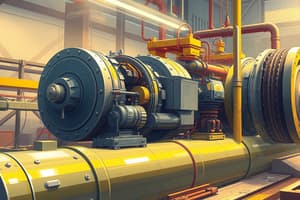Podcast
Questions and Answers
Match the pillar of governance to its description:
Match the pillar of governance to its description:
Transparency = Making information and decision-making accessible to stakeholders. Accountability = Ensuring individuals or entities are responsible for their actions and decisions. Participation = Encouraging active involvement from stakeholders. Fairness = Equitable treatment ensuring no bias in processes.
Match the industry era to its main characteristics:
Match the industry era to its main characteristics:
Industry 1.0 = Steam engine, mechanization Industry 2.0 = Mass production, use of electricity Industry 3.0 = IT systems and robotics, automated production Industry 4.0 = Smart factories, AI, networks
Match the sector with its description regarding the industrial sector:
Match the sector with its description regarding the industrial sector:
Manufacturing = Conversion of raw materials into new products. Services = Activities supporting businesses and consumers, often intangible. Agriculture = Cultivation of plants and rearing of animals. Construction = Building and infrastructure projects.
Match the industrial process to its product use:
Match the industrial process to its product use:
Match the type of energy consumption with its type of industrial production:
Match the type of energy consumption with its type of industrial production:
Match the sector with its corresponding NACE Rev. 2 code letter:
Match the sector with its corresponding NACE Rev. 2 code letter:
Match the sector with its corresponding ISIC Rev. 4 code letter:
Match the sector with its corresponding ISIC Rev. 4 code letter:
Match the fuel type with its common energy use in industrial plants:
Match the fuel type with its common energy use in industrial plants:
Match the fuel with its appropriate type of material use:
Match the fuel with its appropriate type of material use:
Match the type of environmental impact with its corresponding description:
Match the type of environmental impact with its corresponding description:
Match the description with its industrial context:
Match the description with its industrial context:
Match description with its impact mitigation option:
Match description with its impact mitigation option:
Match the Dutch agricultural product with its description:
Match the Dutch agricultural product with its description:
Match the strategy to lower environmental impact to its core approach :
Match the strategy to lower environmental impact to its core approach :
Match the type of waste flow with the best action towards a circular pattern and its description :
Match the type of waste flow with the best action towards a circular pattern and its description :
Match the type of material with its general industrial use:
Match the type of material with its general industrial use:
Match the following pillars of governance with their real-world implications:
Match the following pillars of governance with their real-world implications:
Match the description to a level of circularity:
Match the description to a level of circularity:
Which is the correct match between the definition and the aspect of Industrial Symbiosis?
Which is the correct match between the definition and the aspect of Industrial Symbiosis?
Match the type of environmental assessment with the goal:
Match the type of environmental assessment with the goal:
Match the analytical lens to the aspect.
Match the analytical lens to the aspect.
Flashcards
Governance
Governance
Systems, processes, and structures through which decisions are made.
Transparency
Transparency
Making information and decision-making accessible to stakeholders.
Accountability
Accountability
Ensuring individuals/entities are responsible for actions/decisions, with oversight.
Participation
Participation
Signup and view all the flashcards
The Industrial Sector
The Industrial Sector
Signup and view all the flashcards
Industry 1.0
Industry 1.0
Signup and view all the flashcards
Industry 2.0
Industry 2.0
Signup and view all the flashcards
Industry 3.0
Industry 3.0
Signup and view all the flashcards
Industry 4.0
Industry 4.0
Signup and view all the flashcards
Industry 5.0
Industry 5.0
Signup and view all the flashcards
Energy Use
Energy Use
Signup and view all the flashcards
Material Use
Material Use
Signup and view all the flashcards
Material and Energy Efficiency
Material and Energy Efficiency
Signup and view all the flashcards
Industrial Clusters
Industrial Clusters
Signup and view all the flashcards
Industrial Symbiosis
Industrial Symbiosis
Signup and view all the flashcards
Green Value Chain
Green Value Chain
Signup and view all the flashcards
Circular Economy
Circular Economy
Signup and view all the flashcards
Impact Mitigation Options
Impact Mitigation Options
Signup and view all the flashcards
Low Carbon Transitions
Low Carbon Transitions
Signup and view all the flashcards
"Wicked" Problem
"Wicked" Problem
Signup and view all the flashcards
Study Notes
- This presentation discusses governance in industry, focusing on the industrial sector's environmental impact and emerging technologies.
- Dr. Mar Pérez-Fortes from the E&I section – TPM presented this on March 24, 2025, in Delft.
Governance
- Governance involves the systems, processes, and structures used to make decisions, exercise authority, and manage resources in organizations, governments, or other entities.
- Effective governance ensures accountability, transparency, and fairness while working towards collective goals.
- The main components of governance are:
- Transparency: Making information and decision-making accessible to stakeholders to foster trust and prevent corruption.
- Accountability: Ensuring individuals or entities are responsible for their actions and decisions, with mechanisms for oversight and evaluation.
- Participation: Encouraging active involvement from stakeholders to consider diverse perspectives and enhance legitimacy.
Agenda: Part 1
- The agenda includes the definition and discussion of the industrial sector and its environmental impact:
- Major streams.
- Types of streams, mitigation of emissions and waste, and main actors or stakeholders involved in environmental impact mitigation.
- Key learning objectives are to:
- Recognize the importance of the industrial sector.
- Identify the main inlet and outlet streams and important actors or stakeholders in an industrial plant.
- Describe industrial clusters and industrial symbiosis.
Industry Evolution
- Industry 1.0: Characterized by the steam engine and mechanization.
- Industry 2.0: Mass production in assembly lines with the use of electricity.
- Industry 3.0: Use of IT systems, robotics, and automated production.
- Industry 4.0: Smart factories, artificial intelligence, and networks.
- Industry 5.0: Complements Industry 4.0 by focusing on research and innovation for a sustainable, human-centric, and resilient industry.
- Industry 5.0 shifts from an economic approach to a focus on social value and well-being, putting worker well-being at the heart of the production process, bringing prosperity beyond jobs and growth.
The Industrial Sector
- It is a segment of the economy that includes companies that create physical products, delivering a final service:
- Classification by industrial process and product use includes mineral, chemical, and metal industry; non-energy products from fuels; electronics industry; substitutes for ozone-depleting substances; and others.
- Classification by energy consumption includes iron and steel, cement, ammonia, aluminum, and pulp and paper production.
- In the EU, six member states generate 74% of the value of sold production.
- The sectors of basic metals and fabricated metal products, food, beverages & tobacco, and motor vehicles & transport account for 47% of the value of sold production in 2022.
- The Netherlands’ industries include agroindustries, metal and engineering products, electrical machinery and equipment, chemicals, petroleum, construction, microelectronics, and fishing.
- The Netherlands is a chemical, oil, and machinery exporter, with agricultural products including milk, potatoes, sugar beets, pork, onions, wheat, poultry, tomatoes, carrots/turnips, and beef.
Material and Energy Flows
- Energy use: Combustion of fuels for heat or work.
- Material use: Utilization of fuels in chemical reactions.
- Applications include feedstock, reductant, or non-energy product.
- Energy sources: Natural gas, oil, coal, coal coke, biomass, waste, electricity, heat.
- Energy is used for the industrial process, heating, cooling, computers, and ventilation, as heat for industrial processes and boiler fuel.
- Materials can be Natural gas, Coal, Petroleum coke and Pulverised coal.
- Non-energy material use in industry can be for Ammonia and Hydrogen, Aluminium, Iron and steel, Engines (lubrication), and Road paving.
Environmental Impact
- Global greenhouse gas (GHG) emissions by sector in 2016:
- Energy use in industry: 24.2%
- Transport: 16.2%
- Energy use in buildings (electricity and heat): 17.5%.
- Global warming, acidification, land use, euthrophication, resource depletion, and human and ecotoxicities all contribute to environment damage and ecosystem issues.
Reducing Environmental Impact
- Three key strategies to lowering the environmental impact are:
- Using fewer resources by increasing efficiency, reusing, and recycling.
- Decarbonizing energy sources.
- Replacing fossil fuels with alternative feedstocks like waste, biomass, and CO2.
Industrial Clusters and Symbiosis
- Industrial clusters involve a general cluster structure that includes core companies, auxiliary objects, service objects and complementary objects.
- Industrial symbiosis seeks greater collective benefit than the sum of individual benefits, aims to minimize damage in industrial and ecological systems, and improve communication between companies.
- Symbiotic types:
- Utility exchange.
- Utility network.
- By-product exchange.
- By-product synergy.
- Supply chain co-sitting.
- Waste/nutrient recycling.
- Innovation and business case.
- Knowledge sharing and innovation.
Circular Economy and Mitigation Options
- Circular economy strategies involve refusing and rethinking, reducing, reusing, repairing and refurbishing, and recycling.
- Impact mitigation options that includes, carbon capture, utilization, and storage, changing raw materials and conversion processes, process integration (using waste heat for power generation), and electrification.
Agenda Part Two: Governing Low Carbon Emerging Technologies for Transformative Change
- CO2 electrolysis – an emerging technology.
- TechnoIogical Innovation Systems (TIS) framework.
- Contextual influences on TIS.
- Enablers and Barriers.
Research Goals
- Research goal for CO2 electrolysis is to identify enablers and barriers that influencing its development and diffusion in Europe:
- Goal Includes Identify interventions to unlock its full potential to contribute to sustainable energy transition.
- Governance is needed to protect users, protect the planet, reduce uncertainty, disrupt the status quo, anticipate and minimize harm, and to direct technology towards desirable objectives.
- Low-carbon transitions are disruptive and contested because they threaten economic positions and business models, encounter disagreement over solutions, and require complex negotiations and trade-offs.
- Multiple analytical lenses, combining techno-economic assessments, multi-level perspective, and political economy, are needed to identify enablers and barriers, as each offers only a partial view.
- CO2 electrolysis involves actors like legislators, renewable energy providers, chemical industries, local transportation companies, technology developers, project developers, and end-users.
- CO2 electrolysis may become critical for the European chemical industry post-2050 despite current unlikelihood.
Key Lessons
- Emerging low-carbon technologies face many barriers.
- Resistance also comes from powerful industries with threatened business models.
- Governance is needed to achieve desirable outcomes using policy actions that includes trade-offs and management of uncertainties.
- Analytical lenses can identify key enablers and barriers.
- Combining different frameworks gives a realistic view of needed interventions.
Studying That Suits You
Use AI to generate personalized quizzes and flashcards to suit your learning preferences.




